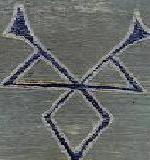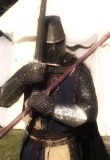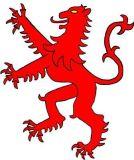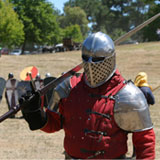 |
|
|
|
| Author |
Message |
Robbo

Location: In the Tree's
|
 Posted: Sat Jun 06, 2009 1:08 pm Posted: Sat Jun 06, 2009 1:08 pm |
 |
|
Baresark!! 
Mouthguard Haiku:
Keep my teeth intact
pretty colours when I grin
Where is yours?
_________________
Hail the Sky Traveller |
|
|
 |
huscarl

Location: in the back of your mind
|
 Posted: Sat Jun 06, 2009 11:11 pm Posted: Sat Jun 06, 2009 11:11 pm |
 |
|
conal wrote "I also use my mouthguard to...
- Reduce chew marks on my top shield edge.
- It is impossible to spit on a banner when wearing a mouthguard.
- You don't have to answer questions, 'cause you can't.
- Cushion impacts when headbutting.
I like this i also keep mine in the same little bag with my cup it fits in there well mmmmmm.

_________________
hail Fraja. |
|
|
 |
Victorius
Location: IMPERIVM ROMANA: The Roman club with a Living History focus.New Roman Club
|
 Posted: Fri Sep 04, 2009 11:57 pm Posted: Fri Sep 04, 2009 11:57 pm |
 |
|
Hmmm...a number of things to consider:
1. All headblow combatants wear mouthguards
2. All headblow combatants have proper suspension harnesses in addition to padding
3 All headblow combatants have visors (easily hidden beneath maille aventails).
Headblow without a suspension harness, no matter the thickness of the helmet and padding, means that downward impact still moves through to the cranium. A suspension harness directs the impact away from the cranium and into the sides of the helmet where the harness is attached.
I would seriously advocates suspension harnesses for all headblow combatants (or all combatants, for that matter). Not having suspension harnesses meant that when a previous trainer was taking our guys and tried to introduce headblow, many of our guys received shock through to the cranium. The helmets were fine, the strikes were safely controlled, but they felt them nonetheless. Now if he had put suspension harness helms on the guys, it might have gone differently. That's why our club (or, at least me) faces an uphill battle convincing our guys that headblow is safe...enough.
_________________
VICTORIVS, BA.MA.HONS.I, IMPERIVM. ROMANA |
|
|
 |
conal
Site Admin
|
 Posted: Sat Sep 05, 2009 2:32 am Posted: Sat Sep 05, 2009 2:32 am |
 |
|
Mouth guard.
Punch for the furniture.
Have a suspension lid already. |
|
|
 |
Oskar der Drachen

Location: Masterton
|
 Posted: Sat Sep 05, 2009 10:33 am Posted: Sat Sep 05, 2009 10:33 am |
 |
|
| Quote: | Victorius wrote...
The helmets were fine, the strikes were safely controlled, but they felt them nonetheless. Now if he had put suspension harness helms on the guys, it might have gone differently. That's why our club (or, at least me) faces an uphill battle convincing our guys that headblow is safe...enough. |
I am getting to the conversation late, so apologies if I ask questions already answered. Interesting conversation backing this thread up though, talk about OT!
Background to make sure I understand, the fighting system is to touch blow standard with not like SCA impact calibration, headblow would be the same. The precautions listed would be to prevent injuries due to error.
How does the person being hit judge the fitness of the strike to the head then, if there is so much padding & suspension between him and the blow? Many times when I have taken a blow to the helmet (SCA) quite justifiably it has not been "good" because of the character of the shot.
- Off target or bad angle
Judged by the way my head moves to the shot, if there is little angular movement at the impact, or if the top of my helm is struck at a rising angle, it feels different to a correctly judged shot.
- Not hard enough with lack of commitment to the shot.
A "bump" or "tap" instead of a "clang" with little to no angular momentum either down into my body mass or in a horizontal direction.
- "tippy" or when the tip has just glanced off the brow or top because the attacker has not been close enough to me.
Again by feel a slight overall impact in no particular direction, I might see the sword or not, and with a "ting" or maybe little sound at all.
All of these thing though have to be judged mainly by how the shot FEELS and secondly by how it sounds. Depending on the build of the helmet you might get more "ring" than is justified. People rebuild their helmets all the time to get rid of the "ring" so they can judge a blow more accurately by the way it feels than by the way it sounds. If I did not feel it, and could only judge by the way it sounds, the judgement process would be a lot harder.
I can agree with the mouthguards and visor requirements, you guys have the knads to be fighting with steel after all.
I was just wary about padding out your helmets too much. How would you judge the fitness of the blow to the head?
Oskar der Drachen |
|
|
 |
Fungus

Location: Taranaki
|
 Posted: Sat Sep 05, 2009 11:05 am helms Posted: Sat Sep 05, 2009 11:05 am helms |
 |
|
As someone who trains with headblow once a week I agree with having a sispention harness in my helm.
Mouth guards are strongly recomended as Conal is right it will help with impact but I have tryed with my kit and I find it hard to breathe with salet and bever.
I also feel that if I cant spit the mouth guard out having enclosed head gear I dont want obstructed breathing in the case of being concussed. (which shouldnt happen anyway)
I think that if you can use a mouth guard with a sispention harness as well
its all good but I am not going to use one unless I have an open face helm.
_________________
We dont play tiddly winks
Twizel shall fall |
|
|
 |
Patch

Location: Auckland
|
 Posted: Mon Sep 07, 2009 1:18 am Posted: Mon Sep 07, 2009 1:18 am |
 |
|
Suspension harness does not direct the force of a blow to the anchor points, the direction of impact is still down, it just allows for the stretch in the (usuially) leather to muffle the impact, spreads the impact pressure across the surface of the bands or wedges depending on how you have rigged it, and provides a natural lock point where you cannot get the helmet to touch your head and directly transfer the shock (unless the suspension material rips).
Also it is worth noting that a suspension rig has less absorption value against a hit that lands any place but the crown, as you get closer and closer to the anchor points the ability of the suspension dome to keep the steel of the helmet from bouncing off your skull reduces proportionately until at the anchor points; force is transmitted directly unless you have regular padding there.
Please don't misinterpret this post, this is just a clarification, I think that suspension padding is excellent value in a helmet, it is very effective, light, cool, and easy to make and maintain.
-Patch. |
|
|
 |
Patch

Location: Auckland
|
 Posted: Mon Sep 07, 2009 1:30 am Posted: Mon Sep 07, 2009 1:30 am |
 |
|
| Quote: | | " to make sure I understand, the fighting system is to touch blow standard with not like SCA impact calibration, headblow would be the same." |
This is only sometimes the case.
If you are with a group that plays a very controlled game then the above idea holds true and in fact you would be perfectly safe with virtually any kind of helmet or padding at all including a rope cap or sturdy leather skullcap. But to be completely certain (we are talking about skulls and faces teeth and eyes here) the old boys of NAAMA insisted on a metal helm. Also they look the part.
As you drift from that perspective of fighting it is obviously more and more important to have better and better protection. Because there are events and clubs that play to different standards now, it is generally worth while to have a very sturdy and well padded helmet to play in even if your own club and events are for controlled, NAAMA style fighting.
For the occasional inter-club hard hitting headblow event, I certainly would want to do the full SCA standard with fencing mesh route I think, and the problems that we are discussing here are, I think, a way of trying to make sure that everyone has full knowledge of what you might need if you start playing the games that dent your 2mm helm all to hell. |
|
|
 |
Oskar der Drachen

Location: Masterton
|
 Posted: Mon Sep 07, 2009 10:26 am Posted: Mon Sep 07, 2009 10:26 am |
 |
|
| Quote: | Patch Wrote.....
For the occasional inter-club hard hitting headblow event, I certainly would want to do the full SCA standard with fencing mesh route I think, and the problems that we are discussing here are, I think, a way of trying to make sure that everyone has full knowledge of what you might need if you start playing the games that dent your 2mm helm all to hell. |
All good there in the reasoning. Please take the following with a sense of tolerance if you know this already....
What you might want to do is include some form of the "progressive give" language in what you use for helmet padding.
I have worn suspension rigged helmets that had NO give in the webbing. Military and working helmets especially. Impact was directly transmitted to the skull. The suspension rig was there simply to keep the hard shell of the helmet away from the skull so that there was simply another "skull" that had to break first before anything hard/pointy/massive/fast got to the surface of your head.
Impact is moderated in an SCA helmet three ways.
1. Mass - The other reason for the heavier plate mandated in the construction. The more mass that has to be placed into motion by a strike the better. The blow is moderated by the mass of the target, the more mass that has to be moved, the less motion there will be. Equal and opposite reaction principle. Principle reason my Master at Arms has a helmet that he has worn for Donkey's Years that has a 10 gauge top on it.
2. Surface area moderation - Impact is diminished and spread by the amount of surface the blow contacts, the theory behind plate armour. I have always made sure then that my helmet padding contacted as much of the surface of my head, as closely as possible. My helmets will stay on my head without a chinstrap, even upside-down. The chinstrap is extra insurance. Suspension rigs diminish the surface area of the skull the impacted helmet imparts.
3. Progressive give of padding - A close fitting set of padding that has give in it diminishes the direct acceleration the skull experiences when the helmet you are wearing gets impacted. The helmet accelerates *first* shortly after that your head starts to move. Energy is bled off into the padding before your skull accelerates. Impact is moderated. The difference between the give factors in coiled rope padding and a good sculpted closed cell foam padding as an example.
So, if you have read this far....
I prefer a closely built progressive give padding system over a suspension harness. It is hotter and more sweaty, but in my semi- informed opinion, safer.
Oskar |
|
|
 |
Patch

Location: Auckland
|
 Posted: Tue Sep 08, 2009 2:08 am Posted: Tue Sep 08, 2009 2:08 am |
 |
|
| Quote: | | What you might want to do is include some form of the "progressive give" language in what you use for helmet padding. |
I absolutely agree with you there Oskar, a good suspension harness backed up with appropriate padding or a good padding rig are both essential if you need to withstand heavy impacts to the helm, and unfortunately it is perfectly easy to construct both badly enough to cause yourself real harm.
Some of my helms have suspension harness and some have padding but only a very few would I consider to have the magic combination of,
thick heavy plate to reduce motion through mass plus full face protection, as well as sufficient all over padding with full surface coverage and enough combination of softness and resilience (I like layered medium and high density foam padding) to be able to muffle impacts from any direction and spread them into a nice gooshy feeling and with a good strong firm chinstrap. All of these components need to be well constructed, secure and comfortable for serious heavy fighting in my opinion.
| Quote: | | I prefer a closely built progressive give padding system over a suspension harness. It is hotter and more sweaty, but in my semi- informed opinion, safer. |
Yeah, that is what I prefer as well for firm head-blow combat.
-Patch. |
|
|
 |
Robbo

Location: In the Tree's
|
 Posted: Tue Sep 08, 2009 11:49 am Posted: Tue Sep 08, 2009 11:49 am |
 |
|
Let me make my case clear too :p
I come from the school of "Safety First". More protection on your scone is a good thing. Facial/head injuries have been a consistent plague to NZ for years.
The blood in my mouth every single morning is a constant reminder of this. The scars around my face are a constant reminder of this ... and all of these occurred when we were all fighting "to the touch", with controlled blows, after lots of training and having club captains vouch for every combatant AND I was wearing some form of metal head protection.
Factor in head blow combat, more armour, requests from those in armour to be hit just a little harder so they can feel it (or know they were hit), vs trying to not hit those without armour hard, differences in fighting styles and time periods (the strikes used with a broadsword would only get you killed if you tried it a rapier fight).
Safety First. Some idiot will get over excited, you will inevitably poke your head out just in time to discover said idiot and gain a new facial scar to wow the girls with. OR, you can wear more protective gear and be safe. Exactly the reason boxer's wear groin guards...it may not be a viable target zone, but accidents happen.
Don't rely on the other guy/girl and their training. Rely on your own, and your own gear.
_________________
Hail the Sky Traveller |
|
|
 |
Rahel
Location: Manawatu
|
 Posted: Tue Sep 08, 2009 12:42 pm safety and such Posted: Tue Sep 08, 2009 12:42 pm safety and such |
 |
|
hi,
I'm new here.
I have been watching with interest the discussion on helms, mouthguards, safety and 'touch-combat'. The touch rule can easily go out of mind when the adrenalin pumps and the instincts get beyond courtesies. If, in spite of disciplined training, one slipped into any frenzied zone during engagement adequate protection would prove useful.
Rahel |
|
|
 |
White Knight

Location: Orcland
|
 Posted: Wed Sep 30, 2009 11:44 am Posted: Wed Sep 30, 2009 11:44 am |
 |
|
I have worn hard hats on construction sites and recieved knocks from falling objects landing on top of my helmet and have walked into objects and been hit on the side of the hard hat (becos I was looking down) and the shock from both has been quite severe.
For this reason I believe that a helmet needs BOTH a leather suspension harness as well as padding.
The suspension harness in a hard hat is rigid and does not give.
I have taken harder blows wearing helmets with thick padding and come of a lot better.
Going back to the original subject of mouth guards....
I was wearing a light fencing mask (of a lower grade) and recieved a thrust to the face from a shinai stick which dented my mask pushing it back into my face leaving a mark on my forehead.
The shock of the blow caused me to clench my teeth so hard that I chipped a tooth.
For this reason I believe that teeth can be damaged by not just a blow to the top of the crown or the jaw but also to the front and back of the head. Perhaps also from the side of the head.
Mouth guards are designed to protect teeth by absorbing impact.
_________________
Living History. Choose to be part of it. |
|
|
 |
Freebooter
Principal Sponsor

Location: Hamilton
|
 Posted: Tue Oct 06, 2009 10:48 am Posted: Tue Oct 06, 2009 10:48 am |
 |
|
| White Knight wrote: | I was wearing a light fencing mask (of a lower grade) and recieved a thrust to the face from a shinai stick which dented my mask pushing it back into my face leaving a mark on my forehead.
The shock of the blow caused me to clench my teeth so hard that I chipped a tooth. |

I've taken thrusts from Longswords to the mask and never had that happen. The only time I've ever seen a mask voided was by a dagger, and that was very messy indeed.
I would have to say that the mask was probably slightly faulty and that your opponent was hitting way too hard with his bamboo stick. A very good reason for making sure your headgear is in good order before playing. Small holes in mesh have a tendency to unzip under stress. Also beware of sabre masks. I prefer 3 weapon masks or epee masks, as they are designed to recieve and deflect thrusts, which a sabre mask is not. A sabre mask has a domed cross section over the face (absorbtion) while the others have a wedge-shaped cross section (deflection).
Re: mouthguards. Breathing inside my close helm is a whole different experience to breathing inside my fencing mask. I doubt I could get enough air in with a mouthguard in the mix as well.
Honestly, I don't feel most hits to the helmet, which has a padded harness in it, and reckon that that is going to be enough for me.
nic |
|
|
 |
conal
Site Admin
|
 Posted: Thu Oct 08, 2009 11:39 pm Posted: Thu Oct 08, 2009 11:39 pm |
 |
|
Cranial weapon injuries from Anglo-Saxon dover
International Journal of Osteoarchaeology
Volume 6, Issue 1, Date: January 1996, Pages: 10-14
T. Anderson
... Sutton Hoo style lid meets Dane-axe? |
|
|
 |
|
|
 Please read the terms of use
Please read the terms of use
 Contact the Site Admin
Contact the Site Admin

